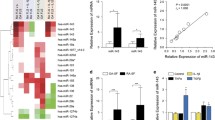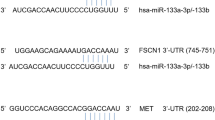Abstract
Background
Altered phenotype of Fibroblast-like synoviocyte(FLS) is an important cause of the pathogenesis and progression of rheumatoid arthritis(RA), but the specific mechanism causing this change has not yet been fully explained. The exact mechanism by which the biological properties of FLS change in RA is still unclear. microRNAs (miRNAs) have been shown to affect changes in the biological properties of RA-FLS, but the critical miRNAs remain to be discovered. Thus, we first used miRNA microarray and WGCNA to confirm the RA-FLS miRNA landscape and establish their biological functions via network analyses at the system level, as well as to provide a platform for modulating the overall phenotypic effects of RA-FLS.
Methods
We enrolled a total of 3 patients with RA and 3 healthy participants, constructed a network analysis of via miRNA microarray and RNA-sequencing. Furthermore, the coexpression analyses of miR-7 and ciRS-7 were verified by siRNA transfection, overexpression and qPCR analyses. Finally, we evaluated the effects of adjusting the expression levels of miR-7 and ciRS-7 on RA-FLS, respectively.
Results
We identified distinct miRNA features in RA-FLS, including miR-7, which was significantly lower expressed. Furthermore, we discovered the negative regulatory relationship between ciRS-7 and miR-7 in RA-FLS. Finally, we overexpressed miR-7 in RA-FLS and discovered that miR-7 inhibited RA-FLS hyperproliferation, migration, invasion, and apoptosis, whereas ciRS-7 overexpression reversed these effects.
Conclusions
The results indicate that the dysregulation of miR-7 in FLS may be involved in the pathological processes of RA and that ciRS-7 induced the suppression of tumor-like biological characters of RA-FLS via modulation of miR-7. These findings help us understand the essential roles of a regulatory interaction between ciRS-7 and miR-7 mediating disease activity of RA, and will facilitate to develop potential intervention target for RA.





Similar content being viewed by others
References
Scott DL, Wolfe F, Huizinga TWJ (2010) Rheumatoid arthritis. Lancet (London England) 376:1094–1108
Nygaard G, Firestein GS (2020) Restoring synovial homeostasis in rheumatoid arthritis by targeting fibroblast-like synoviocytes. Nat Rev Rheumatol 16:316–333
Rodriguez-Trillo A, Mosquera N, Pena C et al (2020) Non-Canonical WNT5A Signaling Through RYK Contributes to Aggressive Phenotype of the Rheumatoid Fibroblast-Like Synoviocytes. Front Immunol 11:555245
Guiducci S, Del Rosso A, Cinelli M et al (2005) Rheumatoid synovial fibroblasts constitutively express the fibrinolytic pattern of invasive tumor-like cells. Clin Exp Rheumatol 23:364–372
Liu Y, Pan YF, Xue YQ et al (2018) uPAR promotes tumor-like biologic behaviors of fibroblast-like synoviocytes through PI3K/Akt signaling pathway in patients with rheumatoid arthritis. Cell Mol Immunol 15:171–181
Stanczyk J, Ospelt C, Karouzakis E et al (2011) Altered expression of microRNA-203 in rheumatoid arthritis synovial fibroblasts and its role in fibroblast activation. Arthritis Rheum 63:373–381
Semaan N, Frenzel L, Alsaleh G et al (2011) miR-346 controls release of TNF-α protein and stability of its mRNA in rheumatoid arthritis via tristetraprolin stabilization. PLoS ONE 6:e19827
Yu S, Lu Y, Zong M, Tan Q, Fan L (2019) Hypoxia-induced miR-191-C/EBPβ signaling regulates cell proliferation and apoptosis of fibroblast-like synoviocytes from patients with rheumatoid arthritis. Arthritis Res Ther 21:78
Ren C, Li M, Zheng Y, Wu F, Du W, Quan R (2021) Identification of diagnostic genes and vital microRNAs involved in rheumatoid arthritis: based on data mining and experimental verification.PeerJ9, e11427
Nakamachi Y, Kawano S, Takenokuchi M et al (2009) MicroRNA-124a is a key regulator of proliferation and monocyte chemoattractant protein 1 secretion in fibroblast-like synoviocytes from patients with rheumatoid arthritis. Arthritis Rheum 60:1294–1304
Renman E, Brink M, Ärlestig L, Rantapää-Dahlqvist S, Lejon K (2021) Dysregulated microRNA expression in rheumatoid arthritis families-a comparison between rheumatoid arthritis patients, their first-degree relatives, and healthy controls. Clin Rheumatol 40:2387–2394
Enuka Y, Lauriola M, Feldman ME, Sas-Chen A, Ulitsky I, Yarden Y (2016) Circular RNAs are long-lived and display only minimal early alterations in response to a growth factor. Nucleic Acids Res 44:1370–1383
Guo Z, Cao Q, Zhao Z, Song C (2020) Biogenesis, Features, Functions, and Disease Relationships of a Specific Circular RNA: CDR1as. Aging and disease 11:1009–1020
Memczak S, Jens M, Elefsinioti A et al (2013) Circular RNAs are a large class of animal RNAs with regulatory potency. Nature 495:333–338
Yang X, Ye T, Liu H et al (2021) Expression profiles, biological functions and clinical significance of circRNAs in bladder cancer. Mol Cancer 20:4
Tang X, Wang J, Xia X et al (2019) Elevated expression of ciRS-7 in peripheral blood mononuclear cells from rheumatoid arthritis patients. Diagn Pathol 14:11
Jiang C, Zeng X, Shan R et al (2020) The Emerging Picture of the Roles of CircRNA-CDR1as in Cancer. Front cell Dev biology 8:590478
Zhang F, Xu Y, Ye W, Jiang J, Wu C (2020) Circular RNA S-7 promotes ovarian cancer EMT via sponging miR-641 to up-regulate ZEB1 and MDM2. Biosci Rep 40
Liu L, Liu FB, Huang M et al (2019) Circular RNA ciRS-7 promotes the proliferation and metastasis of pancreatic cancer by regulating miR-7-mediated EGFR/STAT3 signaling pathway. Hepatobiliary Pancreat Dis Int 18:580–586
Qiang J, Lv T, Wu Z, Yang X (2019) Down-regulation of microRNA-142-3p inhibits the aggressive phenotypes of rheumatoid arthritis fibroblast-like synoviocytes through inhibiting nuclear factor-kappaB signaling.Biosci Rep39
Bi X, Guo XH, Mo BY et al (2019) LncRNA PICSAR promotes cell proliferation, migration and invasion of fibroblast-like synoviocytes by sponging miRNA-4701-5p in rheumatoid arthritis. EBioMedicine
Han JY, Guo S, Wei N et al (2020) ciRS-7 Promotes the Proliferation and Migration of Papillary Thyroid Cancer by Negatively Regulating the miR-7/Epidermal Growth Factor Receptor Axis. Biomed Res Int 2020, 9875636
Dou Z, Gao L, Ren W et al (2020) CiRS-7 functions as a ceRNA of RAF-1/PIK3CD to promote metastatic progression of oral squamous cell carcinoma via MAPK/AKT signaling pathways. Exp Cell Res 396:112290
Zhou X, Li J, Zhou Y et al (2020) Down-regulated ciRS-7/up-regulated miR-7 axis aggravated cartilage degradation and autophagy defection by PI3K/AKT/mTOR activation mediated by IL-17A in osteoarthritis. Aging 12:20163–20183
Wang M, Chen Y, Bi X et al (2021) LncRNA NEAT1_1 suppresses tumor-like biologic behaviors of fibroblast-like synoviocytes by targeting the miR-221-3p/uPAR axis in rheumatoid arthritis. J Leukoc Biol
Cho WC (2007) OncomiRs: the discovery and progress of microRNAs in cancers. Mol Cancer 6:60
Tsuchiya S, Okuno Y, Tsujimoto G (2006) MicroRNA: biogenetic and functional mechanisms and involvements in cell differentiation and cancer. J Pharmacol Sci 101:267–270
Scaria V, Hariharan M, Maiti S, Pillai B, Brahmachari SK (2006) Host-virus interaction: a new role for microRNAs. Retrovirology 3:68
Zhou SS, Jin JP, Wang JQ et al (2018) miRNAS in cardiovascular diseases: potential biomarkers, therapeutic targets and challenges. Acta Pharmacol Sin 39:1073–1084
Marques-Rocha JL, Samblas M, Milagro FI, Bressan J, Martínez JA, Marti A (2015) Noncoding RNAs, cytokines, and inflammation-related diseases. Faseb j 29:3595–3611
Sugatani T, Vacher J, Hruska KA (2011) A microRNA expression signature of osteoclastogenesis. Blood 117:3648–3657
Wen X, Chen X, Liang X et al (2018) The small molecule NSM00191 specifically represses the TNF-α/NF-кB axis in foot and ankle rheumatoid arthritis. Int J Biol Sci 14:1732–1744
Cui X, Song K, Lu X, Feng W, Di W (2021) Liposomal Delivery of MicroRNA-7 Targeting EGFR to Inhibit the Growth, Invasion, and Migration of Ovarian Cancer. ACS Omega 6:11669–11678
Gu W, Chen P, Ren P, Wang Y, Li X, Gong M (2021) Downregulation of TAF9B by miR-7-5p Inhibits the Progression of Osteosarcoma. Onco Targets Ther 14:2917–2927
Pan H, Li T, Jiang Y et al (2018) Overexpression of Circular RNA ciRS-7 Abrogates the Tumor Suppressive Effect of miR-7 on Gastric Cancer via PTEN/PI3K/AKT Signaling Pathway. J Cell Biochem 119:440–446
Xu B, Yang T, Wang Z, Zhang Y, Liu S, Shen M (2018) CircRNA CDR1as/miR-7 signals promote tumor growth of osteosarcoma with a potential therapeutic and diagnostic value. Cancer Manag Res 10:4871–4880
Zhang L, Li Y, Liu W, Li H, Zhu Z (2018) Analysis of the complex interaction of CDR1as-miRNA-protein and detection of its novel role in melanoma. Oncol Lett 16:1219–1225
Chen L, Shi J, Wu Y et al (2020) CircRNA CDR1as promotes hepatoblastoma proliferation and stemness by acting as a miR-7-5p sponge to upregulate KLF4 expression. Aging 12:19233–19253
Kristensen LS, Andersen MS, Stagsted LVW, Ebbesen KK, Hansen TB, Kjems J (2019) The biogenesis, biology and characterization of circular RNAs. Nat Rev Genet 20:675–691
Zhang J, Zhang Y, Ma Y, Luo L, Chu M, Zhang Z (2021) Therapeutic Potential of Exosomal circRNA Derived from Synovial Mesenchymal Cells via Targeting circEDIL3/miR-485-3p/PIAS3/STAT3/VEGF Functional Module in Rheumatoid Arthritis. Int J Nanomedicine 16:7977–7994
Chen S, Luo Z, Chen X (2021) Hsa_circ_0044235 regulates the pyroptosis of rheumatoid arthritis via MiR-135b-5p-SIRT1 axis. Cell Cycle 20:1107–1121
Funding
This work was supported by grants provided from the National Natural Science Foundation of China (No. 81771750).
Author information
Authors and Affiliations
Contributions
All authors contributed to the study conception and design. Material preparation, data collection and analysis were performed by Yunfeng Pan, Zuoyu Hu and Manli Wang. The first draft of the manuscript was written by Jingrong Chen, Weizhen Weng and Ye Chen. All authors commented on previous versions of the manuscript. All authors read and approved the final manuscript.
Corresponding author
Ethics declarations
Competing Interests
The authors declare no conflicts of interest.
Ethics Approval
The research was approved by the ethics committee of the Third Affiliated Hospital at the Sun Yat-sen University and all subjects were given the written informed consent in accordance with the Declaration of Helsinki. The Ethics board approval number is [2020]02–090.
Additional information
Publisher’s Note
Springer Nature remains neutral with regard to jurisdictional claims in published maps and institutional affiliations.
Rights and permissions
About this article
Cite this article
Hu, Z., Chen, J., Wang, M. et al. Rheumatoid arthritis fibroblast-like synoviocytes maintain tumor-like biological characteristics through ciRS-7-dependent regulation of miR-7. Mol Biol Rep 49, 8473–8483 (2022). https://doi.org/10.1007/s11033-022-07666-w
Received:
Revised:
Accepted:
Published:
Issue Date:
DOI: https://doi.org/10.1007/s11033-022-07666-w




